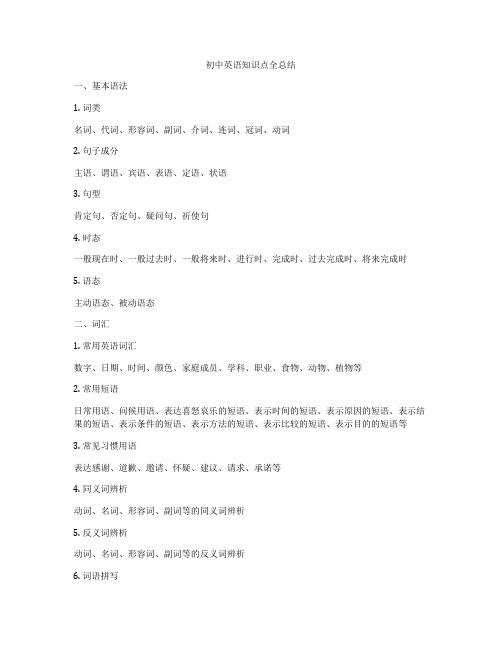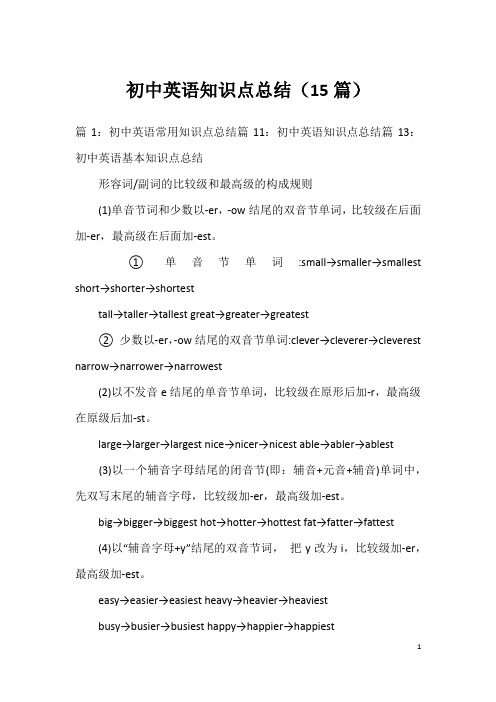初中英语知识点总结归纳
初中英语知识点全总结

初中英语知识点全总结一、基本语法1. 词类名词、代词、形容词、副词、介词、连词、冠词、动词2. 句子成分主语、谓语、宾语、表语、定语、状语3. 句型肯定句、否定句、疑问句、祈使句4. 时态一般现在时、一般过去时、一般将来时、进行时、完成时、过去完成时、将来完成时5. 语态主动语态、被动语态二、词汇1. 常用英语词汇数字、日期、时间、颜色、家庭成员、学科、职业、食物、动物、植物等2. 常用短语日常用语、问候用语、表达喜怒哀乐的短语、表示时间的短语、表示原因的短语、表示结果的短语、表示条件的短语、表示方法的短语、表示比较的短语、表示目的的短语等3. 常见习惯用语表达感谢、道歉、邀请、怀疑、建议、请求、承诺等4. 同义词辨析动词、名词、形容词、副词等的同义词辨析5. 反义词辨析动词、名词、形容词、副词等的反义词辨析6. 词语拼写常见的易错拼写单词、易混淆单词、词汇记忆技巧7. 词语辨析容易混淆的近义词、疑难词语的理解三、句型转换1. 肯定句转换否定句2. 否定句转换肯定句3. 陈述句转换疑问句4. 一般疑问句转换特殊疑问句5. 直接引语转换为间接引语6. 主动语态转换为被动语态7. 定语从句的转换8. 状语从句的转换四、阅读理解1. 阅读短文阅读理解题型、文章的类型、文章的结构、文章的主题,作者的观点和态度分析,文章细节理解等2. 理解词语和短语根据上下文理解词语和短语,推测词义,理解事实和信息,归纳文章主旨等3. 阅读策略找主题句、段落大意概括、理解作者的意图等4. 阅读技巧速读、精读、细读,快速定位等五、听力1. 日常生活对话日常生活对话、问路、购物、订餐、电话、预约、乘坐交通工具等2. 学校生活对话上课、放学、作业、考试、运动会、话剧表演、校园活动等3. 交际用语问候、介绍自己、询问信息、表达感谢、道歉、请求、承诺、邀请、祝福等4. 语音语调语音语调的基本规律和特点,英语连读、舌尖音、上音,语调变化等六、写作1. 书面表达书信、便条、日记、日程安排、活动安排、口头表达等2. 写信格式信头、信尾、日期、称呼等3. 作文结构作文的开头、扩写、过渡、结尾等4. 句式转换改写句子、段落,使表达更加丰富多样5. 表达方式使用例证、比喻、排比、描写等,使文章更生动七、语法专题1. 介词介词的常见用法和搭配2. 连词并列连词、从属连词的用法和区别3. 形容词和副词形容词和副词的比较级和最高级,以及用法区别4. 名词的单数复数名词单数复数的变化规则5. 疑问词及疑问句特殊疑问词和疑问句的结构6. 定语从句定语从句的连接词和用法7. 状语从句状语从句的连接词和用法八、语言运用1. 情态动词can、could、may、might、must、shall、should、will、would、ought to的用法2. 动词的时态和语态一般现在时、一般过去时、一般将来时、进行时、完成时、过去完成时、将来完成时等动词时态,以及主动语态和被动语态的用法3. 句子的语序陈述句、一般疑问句、特殊疑问句、祈使句的语序规则4. 词语辨析同义词、反义词、单词形式的变换5. 词语的搭配不同词义的搭配,固定搭配的用法6. 语法填空根据语境选择合适的词语或词组来填充空白7. 交际用语日常生活中常用的交际用语的表达九、复习技巧1. 听力技巧听力材料的整体理解、选项干扰性的词、对话文章的表达、上下文对比等2. 阅读技巧细节题、主旨题、归纳题、推理题等题型的解题技巧3. 写作技巧书面表达的开头展开结尾的写作技巧4. 背诵技巧词汇、短语的背诵技巧5. 口语表达表达能力的提升、语音语调的模仿等技巧以上就是初中英语知识点的全面总结,希望对学习英语的同学有所帮助。
初中英语知识点总结(完整版)

I don ’t want so much.一般现在时的用法1) 经常性或习惯性的动作,常与表示频腮度的时间状语连用。
时间状语: every …, sometimes, at …, on SundayI leave home for school at 7 every morning.2) 客观真理,客观存在,科学事实。
The earth moves around the sun.Shanghai lies in the east of China.3) 表示格言或警句中。
Pride goes before a fall. 骄者必败。
注意:此用法如果出现在宾语从句中,即使主句是过去时,从句谓语也要用一般现在时。
例: Columbus proved that the earth is round..4) 现在时刻的状态、能力、性格、个性。
Ann Wang writes good English but does not speak well.比较: Now I put the sugar in the cup.I am doing my homework now.第一句用一般现在时,用于操作演示或指导说明的示范性动作,表示言行的瞬间动作。
再如:Now watch me, I switch on the current and stand back. 第二句中的 now 是进行时的标志,表示正在进行的动作的客观状况,所以后句用一般现在时。
2. 一般过去时的用法1 )在确定的过去时间里所发生的动作或存在的状态。
时间状语有: yesterday, last week, an hour ago, the other day, in 1982 等。
Where did you go just now?2 )表示在过去一段时间内,经常性或习惯性的动作。
When I was a child, I often played football in the street.Whenever the Browns went during their visit, they were given a warm welcome.3 )句型:It is time for sb. to do sth " 到……时间了" "该……了"It is time sb. did sth. " 时间已迟了" "早该……了"It is time for you to go to bed. 你该睡觉了。
初中英语知识点总结及重点

初中英语知识点总结及重点一、词汇学习1. 单词拼写:掌握常用单词的正确拼写,注意元音和辅音的发音规则。
2. 词性辨识:了解名词、动词、形容词、副词、介词、连词、冠词等基本词性,并能在句子中正确使用。
3. 词义理解:通过上下文或词典理解单词的基本含义,并能区分近义词的不同用法。
4. 词组搭配:掌握固定搭配和习惯用法,如动词短语、介词短语等。
二、语法知识1. 时态:掌握一般现在时、一般过去时、一般将来时、现在进行时、过去进行时、将来进行时、现在完成时、过去完成时等基本时态的构成和用法。
2. 语态:了解主动语态和被动语态的转换规则及其在不同情境下的运用。
3. 非谓语动词:学习动名词、分词(现在分词和过去分词)以及不定式的用法。
4. 句子结构:理解简单句、并列句和复合句(包括定语从句、状语从句、宾语从句等)的结构和用法。
5. 代词:掌握人称代词、物主代词、反身代词、指示代词、疑问代词等的用法。
6. 形容词和副词:学习形容词和副词的比较级和最高级的构成及用法。
7. 连词:了解并列连词和从属连词的用法,能够正确连接句子。
三、听力技巧1. 预测:根据上下文或问题预测可能听到的信息。
2. 捕捉关键信息:在听力材料中迅速识别关键词和信息。
3. 理解语境:通过语气、语速等线索理解说话者的意图和情感。
4. 归纳总结:听完后能准确归纳和总结听到的内容。
四、阅读理解1. 快速阅读:通过快速浏览抓住文章的主旨大意。
2. 细节理解:能够准确理解文章中的具体信息和细节。
3. 推理判断:根据文章内容进行逻辑推理,推断隐含意义。
4. 词义猜测:遇到生词时能够通过上下文猜测其大致意思。
五、写作技巧1. 文章结构:掌握五段式作文的基本结构,包括引言、主体段落和结论。
2. 语言表达:使用正确的句型和丰富的词汇表达思想。
3. 逻辑连贯:确保文章内容逻辑清晰,使用恰当的连接词。
4. 规范书写:注意大小写、标点符号的正确使用,保持卷面整洁。
六、口语表达1. 发音准确:注意单词的正确发音和句子的语音语调。
初中英语知识点归纳总结.pdf

初中英语知识点归纳总结.pdf一、词汇与短语1. 基础词汇- 常见名词:家庭成员、学校科目、日常用品、颜色、数字、食物等。
- 常见动词:行为动词(如:run, eat, study)、be动词、情态动词(如:can, must, should)。
- 常见形容词:描述人物特征(如:tall, short, kind)、物品特征(如:big, small, new)。
- 常见副词:时间副词(如:yesterday, tomorrow)、频率副词(如:often, usually, never)。
2. 短语搭配- 动词短语:look at, listen to, talk about, play with等。
- 介词短语:in the morning, on the desk, under the bed等。
- 常用表达:How are you? I’m fine, thanks. / What’s your name? My name is... / Can I help you? / Sorry, I don’t know.二、语法知识1. 时态- 一般现在时:表示经常性或习惯性的动作,如:I usually get up at 6:30.- 一般过去时:表示过去某一确定时间发生的动作,如:He visited his grandparents last weekend.- 一般将来时:表示将来某一时间会发生的动作,如:They will go on a trip next month.- 现在进行时:表示正在进行的动作,如:She is reading a book now.2. 句型结构- 陈述句:用来陈述事实或观点,如:The Earth revolvesaround the Sun.- 疑问句:用来提出问题,如:Do you like apples? / Where is your school?- 否定句:用来表示否定意义,如:He doesn’t like milk.3. 代词- 人称代词:主格(I, you, he, she, it, we, they)和宾格(me, you, him, her, it, us, them)。
(最全)初中英语知识点归纳汇总

初中英语知识归纳总结(打印版)第一课时名词一、概述1、名词的属性:表示人或事物的名称抽象概念的词叫名词。
2、名词分普通名词和专有名词。
普通名词是表示某一类人或事物,或某种物体或抽象概念的名称。
如:teacher, desks, plates, milk, box等,专有名词表示某一特定的人、事物、地方团体、党派、国家机关、语言、节日等专用的名称。
(运用)如:China, Chinese, Saturday, June, Green, Beijing, Olympic等。
(专有名词的第一个字母要大写)二、可数名词与不可数名词1、可数名词是指表示人或事物,可以用数来计量的名词,有单复数之分。
如:glass-----glasses; book---- books2、不可数名词是指所表示的事物不能用数来计量。
如:paper, rice, water , milk, tea等。
3、有些名词在特定情况下由不可数变为可数名词。
Light travels faster than sound; (light:光线,不可数)The lights are on. (light:灯,可数)4、不可数名词的量的表示不可数名词一般无法用数来计算,前面不能用a或an或数词来表示数量,它的量往往借助于容器来表示。
如:a glass of milk ------ four glasses of milka piece of paper ------two pieces of papera bag of rice ------three bags of rice三、可数名词的复数形式(识记、运用)1、可数名词在应用时有单复数之分,单数变复数有规则变化和不规则变化两种。
规则变化policeman---policemen; man---men; woman---women;tooth---teeth; foot---feet; sheep---sheep; deer---deer;Japanese--- Japanese; Chinese --- Chinese; fish --- fish四、名词所有格(运用)名词的所有格是表示所有关系的形式,它也有构成上的变化。
初中英语知识点总结归纳

初中英语知识点总结归纳
Unit 1 一、知识点 1.Check in : 在旅馆的登记入住。 Check out: 在旅馆结账离开。
2.By: ①通过…..方式(途径) 。例:I learn English by listening to tapes. ②在…..旁边。例:by the window/the door ③乘坐交通工具 例:by bus/car ④在……之前,到……为止。例:by October 在 10 月前 ⑤被 例:English is spoken by many people. 3.how 与 what 的区别: how 通常对方式或程度提问,意思有:怎么样 如何,通常用来做状语、表语。 what 通常对动作的发出者或接受者提问,意思为 什么,通常做宾语,主语。 ①How is your summer holiday? It’s OK.(how 表示程度 做表语) ②How did you travel around the world? I travel by air.
b
I need a pen to write with.
b
I need some paper to write on.
I don’t have a room to live in.
10. practice , fun 做名词为不可数名词 11. add 补充说 又说 12. join 加入某团体 并成为其中一员 attend 出席参加会议或讲座
b
b
17.a,an 与序数词连用表示“又一” , “再一” 。 例:Please give me a second apple. There comes a fifth girl.
18.have trouble/difficult/problem (in) doing….. 干…..遇到麻烦,困难 19.unless 除非,如果不,等于“if not”本身就表示否定,引导条件状语从句,主句为将 来时,条件状语从句用一般现在时表示将来。 例:My baby sister doesn’t cry unless she’s hungry. =My baby sister doesn’t cry if she isn’t hungry. Unless you take more care, you’ll have an accident. 如果你不多加小心的话,你会出事的。 20.instead: adv. 代替,更换。 例:We have no coffee, would you like tea instead? 我们没有咖啡了,改喝茶好吗? It will take days by car, so let’s fly instead. 开车去要好几天呢,咱们还是坐飞机吧。 Tom was ill, so I went instead.汤姆病了,所以换了我去。
初中英语知识点归纳汇总

初中英语知识点归纳汇总(总41页)--本页仅作为文档封面,使用时请直接删除即可----内页可以根据需求调整合适字体及大小--初中英语知识归纳总结(打印版)第一课时名词一、概述1、名词的属性:表示人或事物的名称抽象概念的词叫名词。
2、名词分普通名词和专有名词。
普通名词是表示某一类人或事物,或某种物体或抽象概念的名称。
如:teacher, desks, plates, milk, box等,专有名词表示某一特定的人、事物、地方团体、党派、国家机关、语言、节日等专用的名称。
(运用)如:China, Chinese, Saturday, June, Green, Beijing, Olympic等。
(专有名词的第一个字母要大写)二、可数名词与不可数名词1、可数名词是指表示人或事物,可以用数来计量的名词,有单复数之分。
如:glass-----glasses; book---- books2、不可数名词是指所表示的事物不能用数来计量。
如:paper, rice, water , milk, tea等。
3、有些名词在特定情况下由不可数变为可数名词。
Light travels faster than sound; (light:光线,不可数)The lights are on. (light:灯,可数)4、不可数名词的量的表示不可数名词一般无法用数来计算,前面不能用a或an或数词来表示数量,它的量往往借助于容器来表示。
如:a glass of milk ------ four glasses of milka piece of paper ------ two pieces of papera bag of rice ------ three bags of rice三、可数名词的复数形式(识记、运用)1、可数名词在应用时有单复数之分,单数变复数有规则变化和不规则变化两种。
policeman---policemen; man---men; woman---women;tooth---teeth; foot---feet; sheep---sheep; deer---deer;Japanese--- Japanese; Chinese --- Chinese; fish --- fish四、名词所有格(运用)名词的所有格是表示所有关系的形式,它也有构成上的变化。
初中英语知识点总结(15篇)

初中英语知识点总结(15篇)篇1:初中英语常用知识点总结篇11:初中英语知识点总结篇13:初中英语基本知识点总结形容词/副词的比较级和最高级的构成规则(1)单音节词和少数以-er,-ow结尾的双音节单词,比较级在后面加-er,最高级在后面加-est。
① 单音节单词:small→smaller→smallest short→shorter→shortesttall→taller→tallest great→greater→greatest② 少数以-er,-ow结尾的双音节单词:clever→cleverer→cleverest narrow→narrower→narrowest(2)以不发音e结尾的单音节单词,比较级在原形后加-r,最高级在原级后加-st。
large→larger→largest nice→nicer→nicest able→abler→ablest(3)以一个辅音字母结尾的闭音节(即:辅音+元音+辅音)单词中,先双写末尾的辅音字母,比较级加-er,最高级加-est。
big→bigger→biggest hot→hotter→hottest fat→fatter→fattest(4)以“辅音字母+y”结尾的双音节词,把y改为i,比较级加-er,最高级加-est。
easy→easier→easiest heavy→heavier→heaviestbusy→busier→busiest happy→happier→happiest(5)其他双音节词和多音节词,比较级在前面加more,最高级在前面加most。
beautiful→more beautiful→most beautifuldifferent→more different→most differenteasily→more easily→most easily(6)有少数形容词、副词的比较级和最高级是不规则的,必须熟记。
good→better→best well→better→bestbad→worse→worst ill→worse→worstold→older/elder→oldest/eldestmany/much→more→most little→less→leastfar →further/farther→ furthest/farthest篇14:初中英语基本知识点总结形容词和副词比较级的用法(1)“甲+be+(倍数)+形容词比较级+than+乙”表示“甲比乙…”或“甲比乙…几倍”。
- 1、下载文档前请自行甄别文档内容的完整性,平台不提供额外的编辑、内容补充、找答案等附加服务。
- 2、"仅部分预览"的文档,不可在线预览部分如存在完整性等问题,可反馈申请退款(可完整预览的文档不适用该条件!)。
- 3、如文档侵犯您的权益,请联系客服反馈,我们会尽快为您处理(人工客服工作时间:9:00-18:30)。
初中英语知识点总结归纳
导读:我根据大家的需要整理了一份关于《初中英语知识点总结归纳》的内容,具体内容:知识点是英语学习中的一个重要的部分,下面是我为大家带来的,相信对你会有帮助的。
:状语从句为了提高同学们的英语复习效率,中国教育在线整理了初中英语语法之状语从句,状语从句...
知识点是英语学习中的一个重要的部分,下面是我为大家带来的,相信对你会有帮助的。
:状语从句
为了提高同学们的英语复习效率,中国教育在线整理了初中英语语法之状语从句,状语从句是用来修饰主句中的动词,副词和形容词的从句。
根据其含义状语从句可分为时间状语从句,地点状语从句,条件状语从句,原因状语从句,结果状语从句,比较状语从句,目的状语从句,让步状语从句。
1. 时间状语从句
(1)时间状语从句常用when, as, while, before, after, since, till, until, as soon as等连词来引导。
例如:
It was raining hard when got to school yesterday.
While he was doing his homework, the telephone rang.
As he walked along the lake, he sang happily.
He had learned a little Chinese before he came to China.
After he finished middle school, he went to work in a factory.
(2)在时间状语从句里,通常不用将来时态,用现在时态表示将来的动作或状态。
例如:
Ill ring you up as soon as I get to New York.
I will tell him everything when he comes back.
He wont believe it until he sees it with his own eyes.
(3)在带有till或until引导的时间状语从句的主从复合句里,如果主句用肯定式,其含义是"一直到......时",谓语动词只能用延续性动词。
如果主句用否定式,其含义是"直到......才......", "在......以前不......", 谓语动词可用瞬间动词。
例如:
The young man read till the light went out.
Lets wait until the rain stops.
We wont start until Bob comes.
Dont get off until the bus stops.
2. 条件状语从句
(1)条件状语从句通常由if, unless引导。
例如:
What shall we do if it snows tomorrow?
Dont leave the building unless I tell you to.
(2)在条件状语从句里,谓语动词通常用现在时态表示将来的动作或状态。
例如:
Ill help you with your English if am free tomorrow.
He wont be late unless he is ill.
(3)"祈使句 + and (or)+ 陈述句" 在意思上相当于一个带有条件状语
从句的复合句。
例如:
Hurry up, or youll be late.
=If you dont hurry up, youll be late.
Study hard and you will pass the exam.
=If you study hard, you will pass the exam.
3. 原因状语从句
(1)原因状语从句通常由because, since, as引导。
例如:
He didnt come to school because he was ill.
As it is raining, we shall not go the zoo.
Since you cant answer the question, Ill ask someone else.
(2)because表示直接原因,语气最强。
Because引导的原因状语从句多放在主句之后。
回答由why提出的问题,只能用because。
As和since语气较弱,一般用来表示明显的原因。
由as和since引导的原因状语从居多放在句首。
例如:
------Why arent going there?
------Because I dont want to.
As he has no car, he cant get there easily.
Since we have no money, we cant buy it.
(3)because和so不能同用在一个句子里。
:一般现在时
英语语法一般现在时表示经常性或习惯性的动作,或表示现在的特征或状态。
那么,英语一般现在时的句子结构和语法特点是怎样的呢?下面为
您讲解一下。
其动词形式是:动词原形(只有第三人称单数作主语时除外,要加-s)其疑问句和否定句需要用助动词do或does
1) 肯定句用行为动词原形表示
They get up very early every morning. 他们每天早晨起来很早。
I visit my grandparents four times a month. 我一个月去看望祖父母四次。
2) 否定句用dont + 动词原形来表示
We do not go shopping on Sundays. 我们周日不去购物。
I dont think you like this colour. 我想你不喜欢这个颜色。
3) 一般疑问句则是把助动词do提前至句首,后面动词用原形。
回答时,肯定用 "Yes, 主语+do";否定句用 "No, 主语+dont"。
Do they go to school at seven oclock? 他们七点去上学吗?
--Yes, they do.
--Do you like this skirt? 你喜欢这条裙子吗?
--No, I dont. 不,我不喜欢。
一般现在时用来表示经常的或习惯性的动作,常与以下的时间状语连用:often 经常,always 总是,sometimes 有时,usually 通常,every day/ week 每天/ 周等。
He usually goes to school by bike. 通常他骑车上学。
I visit my grandparents every week. 我每个星期都去看祖父母。
She is always late for class. 她总是上课迟到。
My parents and I sometimes go out to eat. 我和父母有时出去吃饭。
It often rains here. 这儿常常下雨。
主语为第三人称单数时的一般现在时
一般现在时态,当主语为第三人称单数时,谓语动词也要是第三人称单数,后要加-s或-es。
He likes reading at night. 他喜欢夜里读书。
She usually goes to school by bike. 她平时骑车上学。
The little cat drinks milk every day. 小猫每天都喝牛奶。
转换成否定句要加doesnt,其后的动词用原形。
Kelly doesnt get up early on Saturdays and Sundays. 凯丽星期六星期天起床不早。
He doesnt feel well today. 他今天感觉不舒服。
转换成一般疑问句,句首用Does,其后的动词用原形。
Does he have lunch at school? 他在学校吃午饭吗?
Does it take long by train? 乘火车要很长时间吗?。
